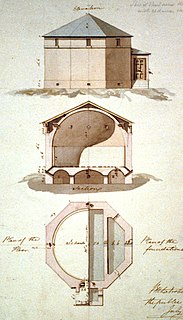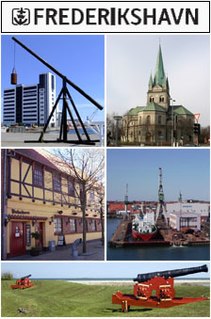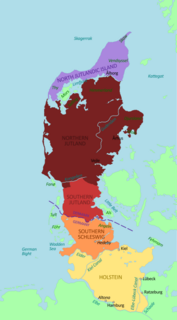
Brønderslev is a town with a population of 12,046 located 31 kilometers north of Aalborg. It is the municipal seat of Brønderslev municipality, Vendsyssel in Region Nordjylland, the northernmost part of the Jutland peninsula in northern Denmark.

Hobro [] is an old market and railway town in Region Nordjylland on the Jutland peninsula in northern Denmark. It has a population of 11,736. The town is situated in a hilly terrain at the head of Mariager Fjord, close to the former Viking fortress of Fyrkat. It is the seat of Mariagerfjord municipality.

The Vordingborg Castle ruins are located in the town of Vordingborg, Denmark and are the town's most famous attraction.
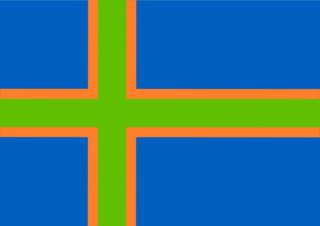
Vendsyssel is the northernmost traditional district of Denmark and of Jutland. Being divided from mainland Jutland by the Limfjord, it is technically a part of the North Jutlandic Island. Vendsyssel is part of the North Denmark Region.

Sønderborg Castle is located in the town of Sønderborg, Denmark on the island of Als in South Jutland. It houses a museum focusing on the history and culture of the area. The castle is located in the middle of the town, in a park setting overlooking Als Fjord. The museum is open year-round.
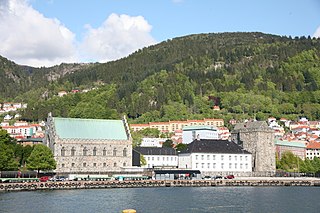
Bergenhus fortress is a fortress located in Bergen, Norway. Located at the entrance of Bergen harbour, the castle is one of the oldest and best preserved stone fortifications in Norway.

The North Jutland Region, on one official website altered to North Denmark Region, is an administrative region of Denmark established on 1 January 2007 as part of the 2007 Danish Municipal Reform, which abolished the traditional counties ("amter") and set up five larger regions. At the same time, smaller municipalities were merged into larger units, cutting the number of municipalities from 271 before 1 January 2006, when Ærø Municipality was created, to 98. North Jutland Region has 11 municipalities. The reform was implemented in Denmark on 1 January 2007.

Råbjerg Mile is a migrating coastal dune between Skagen and Frederikshavn, Denmark. It is the largest moving dune in Northern Europe with an area of around 2 km2 (0.4 mi2) and a height of 40 m (130 ft) above sea level. It is also the only major stretch of migrating dunes in Denmark. The dune contains a total of 4 million m3 of sand. The wind moves it in a north-easterly direction up to 18 metres (59 ft) a year. The dune leaves a low, moist layer of sand behind it, trailing back westwards towards Skagerrak, where the Mile originally formed more than 300 years ago. Over 250,000 people visit the dune every year.
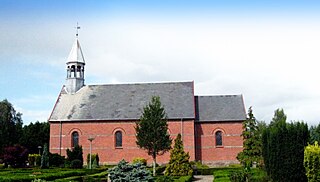
Jerup is a village in Frederikshavn Municipality, Vendsyssel, in the northern Jutland of Denmark.
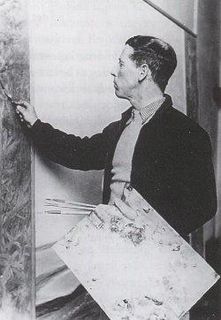
Knud Agger was a self-taught Danish painter. After a series of paintings from everyday life, he became ever involved in painting his family, home and garden at Helsingør in the north of the island of Zealand. With time, his work took on a visionary and strongly existentialist character.

The Fredericia–Aarhus Line is a 108.5 km (67.4 mi) long standard-gauge double-track railway line in Denmark which runs between the cities of Fredericia and Århus in East Jutland. It constitutes a section of the East Jutland Main Line, the through railway line through the Jutland Peninsula from Padborg to Frederikshavn.

Dybvad is a small town situated in the south of Frederikshavn Municipality in north Jutland, Denmark.
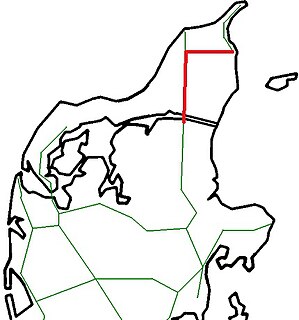
The Vendsyssel Line or the Vendsyssel Railway is a 80.7 km (50.1 mi) long standard gauge single track railway line in Denmark which runs through the historical region of Vendsyssel between Aalborg and Frederikshavn. It constitutes the northernmost part of Den Østjyske Længdebane, the through route through the Jutland Peninsula from Padborg to Frederikshavn.

The fortifications of Copenhagen underwent a comprehensive modernization and expansion in the 17th century. The project was commenced and was largely the masterplan of Christian IV in the early 17th century but was continued and completed by his successors. The new fortifications relied on the existing, medieval fortifications of the city but the fortified area was extended and a defensive ring around the city completed particularly with new edifices facing the sea. The ring fortification consisted of four bastioned ramparts and an annexed citadel as well as various outworks.

The Skagen Odde Nature Centre, on the northern tip of Denmark's Jutland, is a museum devoted to the effects of sand, water, wind and light. It was designed in 1989 by Jørn Utzon, the celebrated architect behind the Sydney Opera House. Under the leadership of his son Jan, the centre was completed in 2000.

Skagen Odde, also Skagens Odde, sometimes known in English as the Scaw Spit or The Skaw, is a sandy peninsula which stretches some 30 km (19 mi) northeast and comprise the northmost area of Vendsyssel in Jutland, Denmark.

Højen or Gammel Skagen on the west side of Skagen Odde is an old fishing community which now forms part of the town of Skagen in the far north of Jutland, Denmark.

Skagen's White Lighthouse is a historic lighthouse just north of the town of Skagen in the far north of Jutland, Denmark. It was operational from 1747 to 1858 when it was replaced by Skagen Lighthouse.


